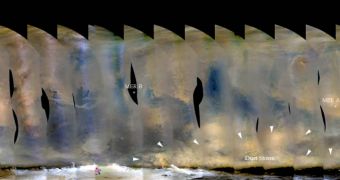Man's presence on Mars these days is absolutely amazing – two rovers that operate since 2004, a lander that was able to conclude without a doubt that water existed on mars, and an orbiter capable of surveying and analyzing the surface of the planet with the same accuracy as Earth-orbit observation satellites do. And it's precisely these achievements that allow mission controllers at NASA to forecast weather on the Red Planet and to engage the Spirit and Opportunity rovers in evasive maneuvers.
Dust storms are extremely dangerous for the machines, because they can either destroy the tiny robots directly, by picking them up and slamming them to the ground, or indirectly, by depositing large amounts of sand on their solar panels. It goes without saying that the exploration vehicles have no other source of electricity, and that they would eventually “die” once their batteries run out.
“Since the rovers are solar powered, the dust in the atmosphere is extremely important to us,” Spirit and Opportunity Chief of the engineering team Bill Nelson, an expert at the jet Propulsion Laboratory, in Pasadena, California, said.
“We can identify where dust is rising into the atmosphere and where it is moving from day to day. Our historical baseline of observing Martian weather, including data from the Mars Global Surveyor mission from 1998 to 2007, helps us know what to expect. Weather on Mars is more repetitive from year to year than weather on Earth. Global dust events do not occur every Mars year, but if they do occur, they are at this time of year,” Mars Color Imager Principal Investigator, Malin Space Science Systems expert Michael Malin added.
The Thermal Emission Imaging System, on the Mars Odyssey, and the Mars Climate Sounder, on the Mars Reconnaissance Orbiter (MRO), survey the amounts of dust in Mars' atmosphere, as well as the temperature variations they cause. The MRO is also able to detect the rovers and the lander with a great degree of accuracy. By predicting the course of a dust storm, scientists in charge of the two exploring robots can take steps to ensure that they do not run out of energy while the dust blows.
They can shorten the average length the robots travel each day and this allows for a lot of energy conservation. “Bruce's weather reports have let us be more aggressive about using the rovers. There have been fewer false alarms. Earlier in the mission, we backed off a lot on operations whenever we saw a small increase in dust. Now, we have enough information to know whether there's really a significant dust storm headed our way,” Texas A&M University College Station atmospheric scientist for the MER mission Mark Lemmon shared.

 14 DAY TRIAL //
14 DAY TRIAL //